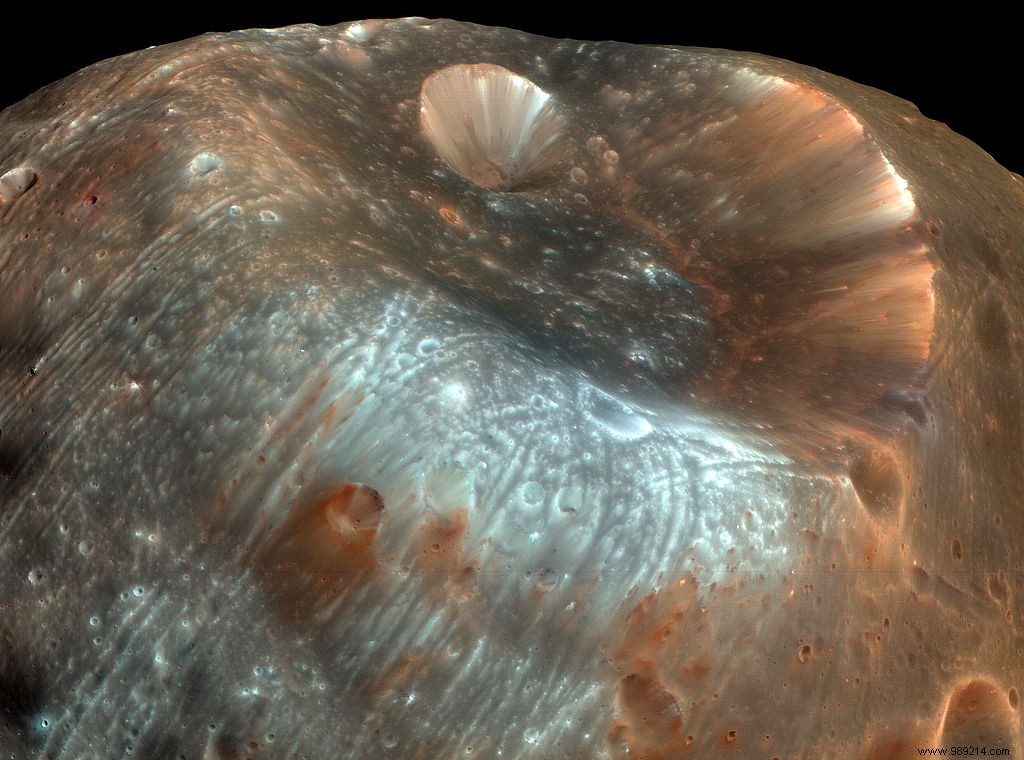The Japanese space agency (JAXA) is preparing for a major mission to bring back samples from the moon Phobos by 2029. In doing so, the scientists hope to find clues to the origins of the two Martian moons and Mars itself, and possibly even traces of past life.
JAXA recently confirmed the development of its Martian Moon eXploration (MMX) mission. The objective will be to land on Phobos, the larger of the two moons of Mars, in order to collect samples . The material will then be brought back to Earth to be analyzed by state-of-the-art instrumentation. The mission is due to take off in 2024 with a planned return in 2029 . If all goes as planned, Japan will therefore bring back its Mars samples before the joint NASA/ESA mission supposed to return with those set aside by the Perseverance rover in the early 2030s.
Remember that this would not be a first strictly speaking for the Japanese space agency. The Hayabusa probe had indeed already landed on the asteroid Itokawa in 2005, with a successful return of samples in 2010. More recently, the Hayabusa 2 probe returned to Earth with several tens of grams of rock collected in its luggage. on the asteroid Ryugu.
According to Japanese plans, the mission should arrive in the Martian system in 2025, about a year after its departure. The orbiter will aim to study Phobos and Deimos, the two Martian moons, before entering a quasi-satellite orbit (QSO) around Phobos to collect scientific data.
The probe will then approach the moon to release a surface lander. A rover will then be deployed to capture at least ten grams of samples about two centimeters below the surface, then the lander will take off with the aim of joining the probe and transferring the cargo to it. Finally, the probe will return to Earth.

One of the objectives of the mission will be to study how water ended up being transported between the inner bodies of the early Solar System.
Scientists believe that these planetary objects were initially too close to the Sun to be able to retain liquid water on the surface. According to the theory, this could then have been delivered by asteroids . However, Phobos and Deimos look like asteroids. If so, they were likely grabbed by Mars' gravity billions of years ago, providing the planet with its water. Mars being the outermost of the inner planets, it could then have served as a "gateway" for this material transfer.
It's also possible that Phobos and Deimos are actually not ancient asteroids, but "pieces" of Mars ejected after a giant impact . The MMX mission will try to find out. This work could then make it possible to acquire new knowledge on the process of formation of Mars and the terrestrial planets.
In addition, some experts suggest that due to its position, Phobos should be considered as a possible base for human exploration of Mars, allowing easier access to the planet than to settle directly on the red planet. One of the "secondary" objectives of the MMX mission will therefore be to determine its reception capacity .

Finally, a recent paper published by the JAXA Institute for Space and Astronautical Research proposes that Phobos may also have preserved traces of past Martian life> .
For billions of years, meteor impacts have ejected chunks of the planet fast enough to launch them into orbit. Some of these pieces have even fallen to Earth, like the Allan Hills 84001 meteorite, found in Antarctica. It is therefore possible that similar rocks are present on Phobos. If Mars was once a habitable planet, then some of them might contain chemical biosignatures or even fossilized microorganisms. At least that's what scientists hope. The MMX mission could help test this theory.
Ryuki Hyodo and Tomohiro Usui, the authors of this article, also explain why Phobos could provide a unique opportunity to assess whether Mars once supported life.
The Perseverance rover is currently collecting samples in Jezero crater for later return to Earth, while ESA's next ExoMars mission will land in Oxia Planum in 2023 for it too go in search of signs of past life. These two missions are naturally very interesting and these two drop points were obviously not chosen at random. On the other hand, although they are mobile, these two missions will only sample relatively limited geological areas.
Conversely, computer simulations revealed that the surface of Phobos was laden with Martian material excavated from countless small randomly produced impacts on the planet's surface. Also, sampling Martian remains on Phobos could provide more geological diversity and therefore possibly more chance of isolating traces of ancient extraterrestrial microbial life.